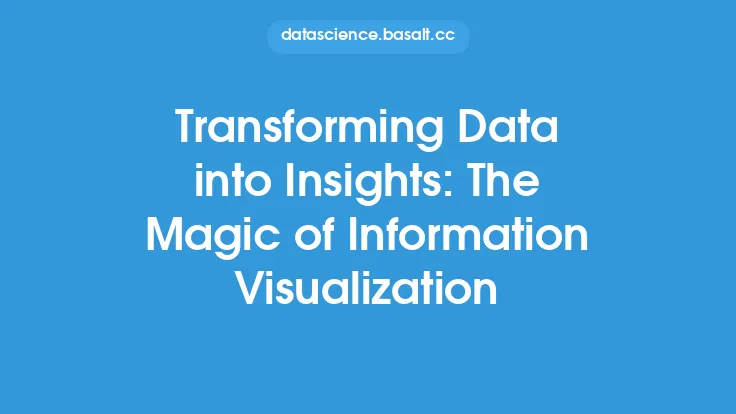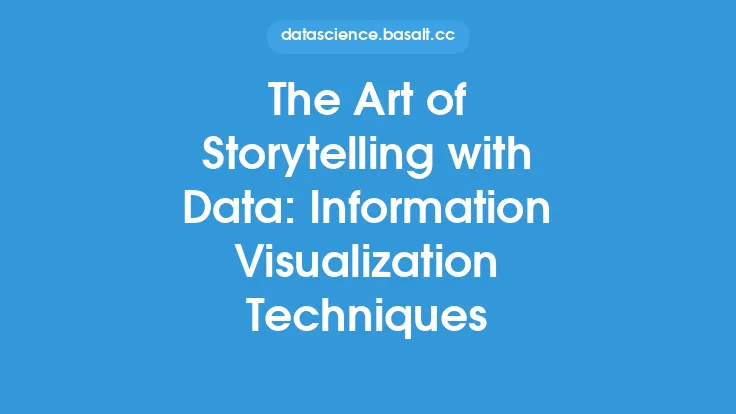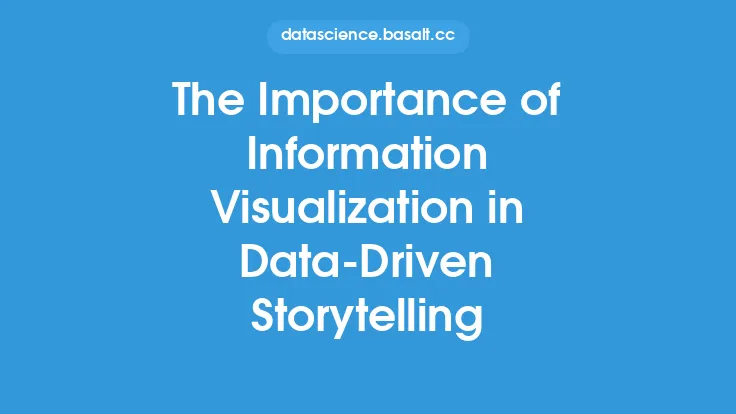The field of data science has experienced tremendous growth in recent years, driven by the increasing availability of large datasets and the need to extract insights from them. At the heart of this field lies the concept of information visualization, which refers to the process of using visual representations to communicate information and knowledge gained from data. Information visualization is a crucial aspect of data science, as it enables researchers and analysts to identify patterns, trends, and relationships within complex data, and to present their findings in a clear and concise manner.
Introduction to Information Visualization
Information visualization is a multidisciplinary field that draws on techniques from computer science, statistics, and design to create interactive and dynamic visualizations of data. The goal of information visualization is to facilitate understanding and insight into complex data, and to support decision-making and knowledge discovery. Information visualization involves a range of activities, including data preparation, visualization design, and interaction with visualizations. It also requires a deep understanding of the data being visualized, as well as the needs and goals of the intended audience.
Types of Information Visualization
There are several types of information visualization, each with its own strengths and weaknesses. Some common types of information visualization include:
- Static visualizations: These are non-interactive visualizations that are typically used to present summary information or to illustrate a specific point. Examples of static visualizations include bar charts, line graphs, and scatter plots.
- Interactive visualizations: These are visualizations that allow users to engage with the data in real-time, using techniques such as filtering, zooming, and hovering. Examples of interactive visualizations include dashboards, interactive charts, and geographic information systems (GIS).
- Dynamic visualizations: These are visualizations that change over time, often in response to changes in the underlying data. Examples of dynamic visualizations include animations, simulations, and real-time data feeds.
- 3D visualizations: These are visualizations that use three-dimensional graphics to represent complex data. Examples of 3D visualizations include virtual reality (VR) and augmented reality (AR) environments, as well as 3D models and simulations.
Techniques for Effective Information Visualization
Effective information visualization requires a range of techniques, including:
- Data preparation: This involves cleaning, transforming, and aggregating the data to create a suitable format for visualization.
- Visualization design: This involves selecting the most appropriate visualization type and customizing its appearance to effectively communicate the insights and patterns in the data.
- Color and typography: These are critical elements of visualization design, as they can greatly impact the clarity and readability of the visualization.
- Interaction design: This involves designing the interactive elements of the visualization, such as filters, zooming, and hovering, to create a seamless and intuitive user experience.
Tools and Technologies for Information Visualization
There are many tools and technologies available for creating information visualizations, including:
- Programming languages: Such as Python, R, and JavaScript, which provide a range of libraries and frameworks for creating custom visualizations.
- Data visualization software: Such as Tableau, Power BI, and D3.js, which provide interactive and dynamic visualization capabilities.
- Geographic information systems (GIS): Such as ArcGIS and QGIS, which provide specialized tools for visualizing and analyzing geospatial data.
- Virtual reality (VR) and augmented reality (AR): Which provide immersive and interactive environments for visualizing complex data.
Applications of Information Visualization
Information visualization has a wide range of applications, including:
- Business intelligence: Where it is used to support decision-making and strategic planning.
- Scientific research: Where it is used to visualize and analyze complex data, and to communicate research findings.
- Education: Where it is used to create interactive and engaging learning materials.
- Government and policy: Where it is used to inform policy decisions and to communicate information to the public.
Best Practices for Information Visualization
To create effective information visualizations, it is essential to follow best practices, including:
- Keep it simple: Avoid clutter and complexity, and focus on communicating a clear and concise message.
- Use intuitive design: Use design elements that are intuitive and easy to understand, such as simple colors and typography.
- Provide context: Provide sufficient context for the visualization, including labels, titles, and legends.
- Test and refine: Test the visualization with a range of users, and refine it based on feedback and iteration.
Future Directions for Information Visualization
The field of information visualization is constantly evolving, with new technologies and techniques emerging all the time. Some future directions for information visualization include:
- Increased use of artificial intelligence (AI) and machine learning (ML): To create more automated and personalized visualizations.
- Greater emphasis on storytelling and narrative: To create more engaging and effective visualizations.
- Increased use of virtual reality (VR) and augmented reality (AR): To create more immersive and interactive visualizations.
- Greater focus on accessibility and inclusivity: To create visualizations that are accessible and usable by a wide range of users.





